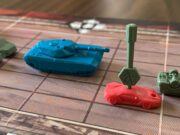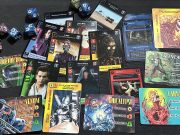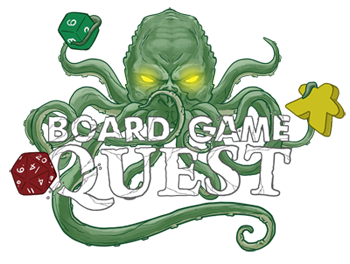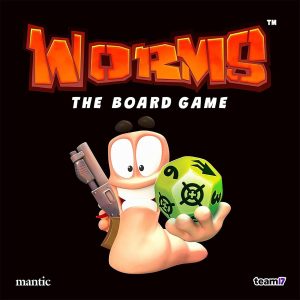 Things that were on my list of “did not expect to see this” last year would have included a board game based on a video game series dating back to the 90s, based on Worms using guns and explosives on one another. Yet here we are.
Things that were on my list of “did not expect to see this” last year would have included a board game based on a video game series dating back to the 90s, based on Worms using guns and explosives on one another. Yet here we are.
Worms: The Game is now Worms: The Board Game. Thanks to Mantic Games, the long-running Worms from Team 17 graces tabletops, with all the silliness that entails (and if you are unfamiliar with the video game version, that’s a lot of silliness).
It is a game for 2-4 players (though the Kickstarter version expands that to up to 6), and it plays relatively quickly in 30-45 minutes.
Gameplay Overview:
Each player has a team of four worms and a handful of destructive equipment in their arsenal. The goal is to come out on top in this brawl of militarily inclined invertebrates. On your turn, you activate one of your team’s worms, allowing you to gather additional supplies (that is, mayhem-causing weapons), heal, strategically move around the terrain, and attack your opponents’ worms… or at least try to attack them, since things do not always go as planned.

The game is designed to fit 2 to 4 players, and the board and game length are scaled to your chosen count. The hex-based terrain is assembled at the start of every game with one tile per player, keeping the action confined, the smaller the player count. There is also a Drop card deck, which functions as a soft timer on the game, which is smaller with 2 or 3 players.
A turn is fairly structured. Once you select your worm, you collect any supplies on your current hex and heal the worm if damaged. Throughout the course of the game, when a worm is damaged by any of the myriad dangers, they are placed on their side. If damaged again before healing, that worm is destroyed.
Your chosen worm can then optionally move twice, either inching safely a single hex, or jumping farther but risking being blown off course. Lastly, you may (and probably should) play one of your weapons to manipulate the board, cause chaos, and hopefully damage other worms (but sometimes your own…). Before play passes to the next player, a Drop card is drawn to resupply the board with supplies, mines, and explosive oil drums.
Ultimately, the goal is to have the most worms still standing at the end of the game. In 3- and 4-player, once one player is eliminated the remaining players play a final round, and whoever has the most surviving worms after that round is the winner. In 2-player, the end is much simpler, with the not-eliminated player being the winner immediately.
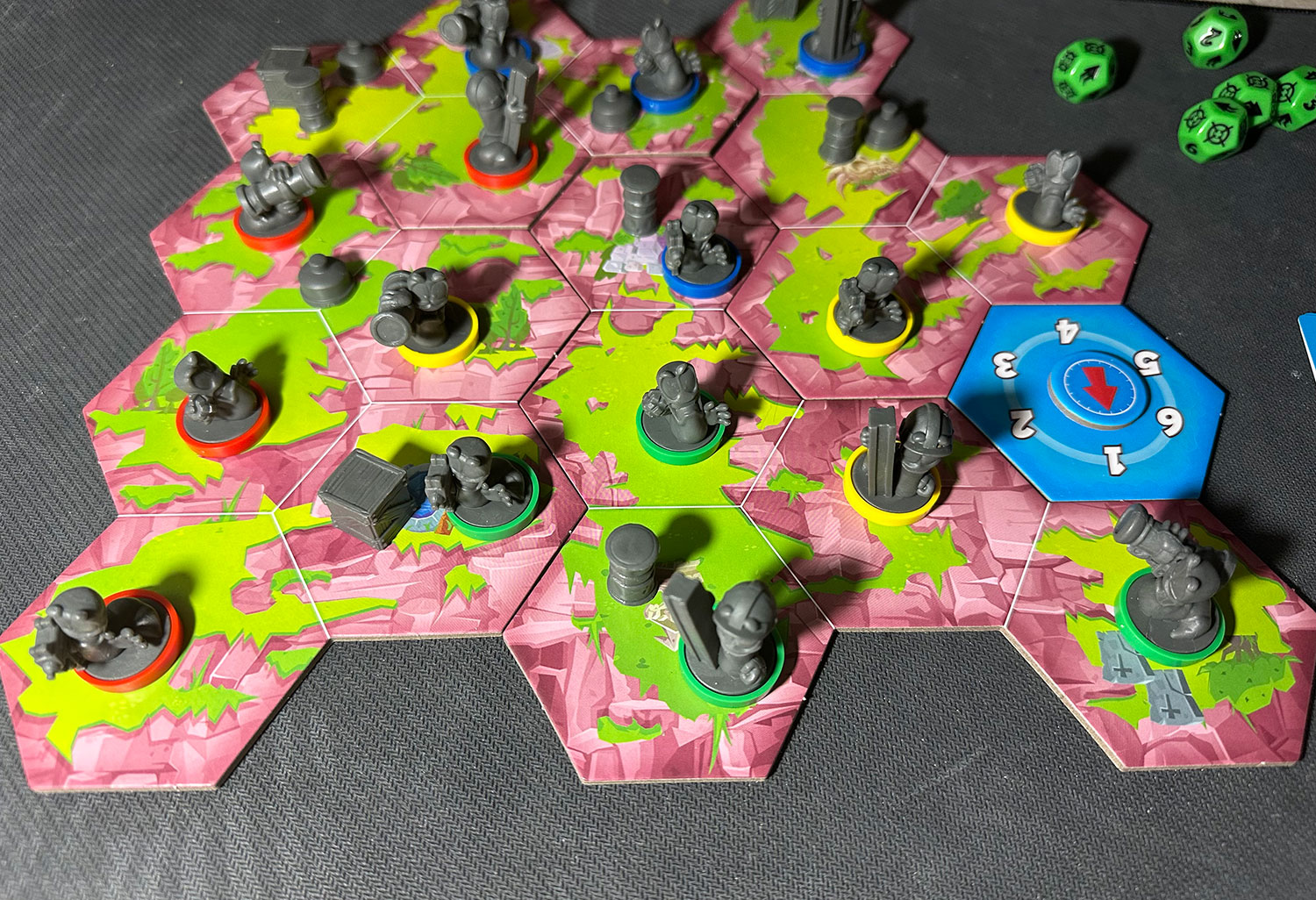
Game Experience:
If there were one word to describe the gameplay of Worms, it would be “chaos.” Even when you understand your goal, and the strategy behind the game, things will often go awry. There is a lot of dice rolling going on. The 5 dodecahedra are used extensively for the Scatter mechanic. When you Scatter a hex or a Thing, you roll one of the dice and compare the result to the handy wind “dial.” The object being moved (either a Thing in the hex, or sometimes a target token or fire) are placed in the direction rolled, or when the wind icon is rolled, the current direction of the wind (which will typically change with every Drop card at the end of a turn).
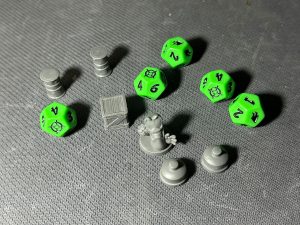
When I say Scatter is used extensively, I’m not overstating it. You roll for direction multiple times on most turns. The above-mentioned risk inherent to jumping is that you Scatter the worm that jumps after the jump, which could move you into a hazard such as a mine or fire, or even into water (which is instant death). Many weapons have less accuracy over longer ranges (such as the Bazooka), and that’s represented by targeting a hex with a token, and then using Scatter on that target, which results in hitting a hex you maybe did not intend. Oil drums explode when damaged and spread fire in directions indicated by the dice, and so on. In other words, there is a lot of dice rolling.
To add another level to the chaos, there is also what the game calls the Danger Flipper, which is just a fancy word for a coin with Worms graphics. It has a danger side and a safe side. When triggering certain events, you flip it like a coin. If it comes up safe, typically nothing happens; but if it comes up on the danger side, you’re probably in trouble and will be taking some damage from whatever the hazard is.
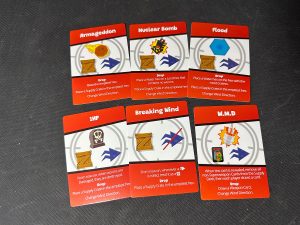
On the one hand, the 50/50 chance of something not happening keeps options open for you. Moving through a mined hex might not result in any negative consequences… but it is adding another layer of randomness to the proceedings (though I suspect this is the point). I didn’t object to the concept of it. Physically flipping the token though, was an aspect I was not a fan of.
The game is fast-paced, however, so I suspect this high degree of randomness is necessary to keep itself fresh. Not only do the turns proceed at a quick pace, but there is a real time limit on the game. The Drop deck at the end of every turn replenishes the board, but it is limited, and once it runs out, Sudden Death begins. There are several Sudden Death cards, and you choose one randomly for each game. All their effects modify the rules on each player’s turn to hasten the game to its conclusion and prevent the game from turning into a slog.

For example, the W.M.D Sudden Death card removes all the “normal” weapons (like guns, girders, etc.) from the Supply deck but leaves all the “superweapons”—that is, weapons that have over-the-top effects. When everyone has them, worm bodies start flying. Other Sudden Death cards are similar. Things generally don’t last very long once the Sudden Death card comes out.
The other method for keeping the game short are the water hex tiles. Frequently with the explosions going off, crater tokens are placed on the board. When a hex has three of them, it is covered up by a water hex, and well, worms can’t swim! Any worm entering a water hex is destroyed. Inevitably more of the board will be covered by water, which will also bring the game to a quick conclusion.
Final Thoughts:
You must take every game for what it is and what it is trying to be, and a game about semi-anthropomorphic worms packing Uzis and blowing each other up is not trying to be a serious game. The chaos is a clear attempt to replicate the zaniness of the source material, and it does succeed on that front. I think it accomplishes what it is trying to do. If you’re looking to have some brainless fun, I think you can play Worms, and that mission will be accomplished.
However, I feel like the randomness, while perhaps thematically appropriate, takes things a few steps too far. I’m not wanting high-level strategy from a game like this, but I feel like some degree of strategy would be acceptable. As it is, it is very hard to make any kind of plan at times. The dice just go against you sometimes, sabotaging what you are planning all too frequently (and I personally avoid situations involving the flipper at all costs). I would have liked to feel more in control of the proceedings.
Overall, Worms: The Board Game at the very least does not overstay its welcome. With the standard game length set up due to the quick pace of the turns, the game is over before you know it, and Sudden Death can be pretty exciting at how it forces that conclusion, rather than draws it out. I don’t think this is a game I personally would seek out to play, but if someone suggested it, I also would not say no.
Final Score: 3 Stars – A silly game that is about as serious as you expect a game about worms toting guns to be, which sabotages itself a bit by leaning too far into the chaos.
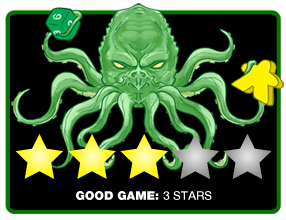 Hits:
Hits:
• The game is fast-paced. From turn length to overall game time, nothing about this game is slow.
• Sudden Death effects are entertaining and switch the game up before it can drag on too long.
Misses:
• Don’t bother to plan for anything. Well, plan for nothing going the way you plan it will. That’s the best plan.
• The Danger Flipper is a bit of an annoying mechanic and is just annoying to use.




